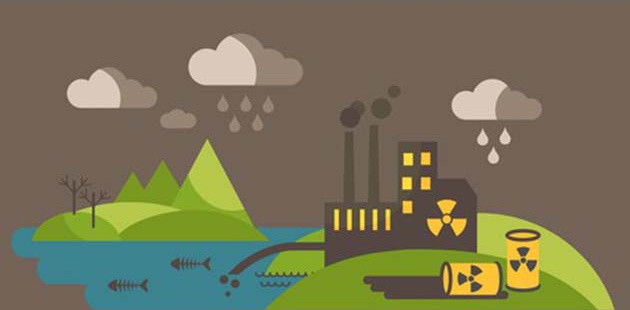研究产生了一种可以吸附空气和水污染物的新材料,并且可以作为目前使用的活性炭的低成本可持续替代品
污染 使我们星球的土地、水、空气和其他环境成分变脏、不安全和不适合使用。 污染 是由人工将污染物引入或进入自然环境引起的。 污染有多种类型; 例如,土地污染主要是由商业公司的生活垃圾或垃圾和工业废物造成的。 当外来物质包括化学品、污水、杀虫剂和化肥或汞等金属时,就会造成水污染。 空气污染是由燃烧燃料产生的空气中的颗粒引起的,如煤烟,其中含有数百万个漂浮在空气中的微小颗粒。 另一种常见的空气污染是危险气体,例如二氧化硫、一氧化碳、氮氧化物和化学蒸气。此外, 空气污染 也可以以温室气体(例如二氧化碳或二氧化硫)的形式出现,并通过温室效应帮助我们的星球变暖。 当来自飞机、工业或其他来源的声音达到有害水平时,其他类型的污染是噪音污染。
尽管近年来为清理环境做出了重大努力,但污染仍然是一个主要问题,并对健康构成持续威胁,影响到全世界 200 亿人。 不可否认,发展中国家的问题最为严重,那里的工业排放、卫生条件差、废物管理不善、供水受污染和暴露于生物质燃料造成的室内空气污染等传统污染源影响了大量人口。 然而,即使在发达国家,环境污染依然存在,尤其是在社会较贫穷的阶层中。 虽然发展中国家的风险普遍较高,但贫困、采用技术的经济限制和薄弱的环境法共同导致高污染水平。 不安全的水、卫生条件差、卫生条件差和室内空气污染进一步加剧了这种风险。 污染对未出生和成长中的儿童有不利影响,由于癌症和其他疾病,预期寿命可能低至 45 岁。 空气和水污染 是一个无声的杀手,被认为会对我们的星球乃至人类产生不利影响。我们呼吸的空气具有非常明确的化学成分,其中 99% 是氮气、氧气、水蒸气和惰性气体。当通常不添加到空气中的物质时,就会发生空气污染。颗粒物——空气中发现的、发电厂、工业、汽车和火灾排放的固体颗粒和液滴——现在在城市甚至郊区无处不在。此外,每年有数百万吨工业废水排放到世界水域。颗粒物和染料对环境、生态系统和人类都有剧毒。
Various methods and procedures are routinely used for tackling air and water pollution, including filtration, ion-exchange, coagulation, decomposition, adsorptionetc and each of these methods exhibit different rates of success. When compared, adsorption is considered most feasible because of being simple, easy to operate, having high efficiency, convenience to use etc. Among the various adsorbents, in pollution abatement of air and waste water, activated carbon is the most commonly used adsorbent. Also called activated charcoal, itis a form of carbon processed to have small, low-volume pores that increase the surface area available for adsorption or chemical reactions. In fact, activated carbon is the gold standard in adsorbents. Carbon has a natural affinity for 有机 pollutants like benzene, which bind to its surface. If you “activate” carbon i.e. steam it at 1,800 degreesit forms little pores and pockets that increase its surface area. Pesticides, chloroform, and other contaminants slide into the holes of this honeycomb and hold fast.Also, no carbon remains in the water once it’s been thoroughly treated.Water treatment plants in developing countries like China and India routinely use activated carbon. Similarly, activated carbon has special properties which help in removing volatile compounds, odours, and other gaseous pollutants from the air. The way it works is quite straightforward. There are a few downsidesof activated carbon, firstly it is very expensive and has a very short shelf life as it can only be used until its pores fill up – which is why you have to change the filterfrom time to time. Activated carbon is also difficult to regenerate and its effectiveness decreases over time. They are not effective at removing those contaminants which are either not attracted to carbons or pathogenic bacteria and viruses.
经济和可持续的替代方案
在最近发表的一项研究中 化学前沿, researchers have a created an affordable low-cost and sustainable material for tackling air and water pollution. This new “green” porous material produced from solid wastes and abundant 有机 natural polymers looks very promising in terms of adsorbing pollutants in wastewater and airwhen compared to activated carbon and is being labelled as an “economical alternative”. This new “green” adsorbent is a combination of a naturally abundant raw material – a polysaccharide called sodium alginate which can be extracted from seaweed and algae–with an industrial by product – silica fume (by product of silicon metal alloy processing). It was synthesised very easily and consolidated by the gelling properties of alginate and by decomposition of sodium-bicarbonate controlled porosity at low temperatures at different scale lengths. For testing in the wastewater pollution, a blue dye was used as a model pollutant. It was seen that the new hybrid material adsorbed and removed the dye with efficiency of about 94 percent, which was very encouraging. Even very high concentrations of this dye were removed. This material displayed encouraging capabilities for trapping particulate matter from diesel exhaust fume. The study led by Dr.ElzaBontempi from the University of Brescia, Italy, concludes that this material was able to replace activated carbon very efficiently in its capability to capture both fine particulate matter in air and also 有机 pollutants in wastewater thus cutting down on the pollution.
This is exciting work, as this new material is produced in a very innovative and inexpensive manner from naturally abundant polymers and industrial waste by-product which is anyway is always discarded. This new material being termed as an “有机-inorganic hybrid” is not only low cost, it’s also sustainable and regenerable and could actually displace the activated carbon and become a preferred choice. It even consumed less energy when being produced (the “embodied” energy) and thus leaves a much lower carbon footprint. This material is also self-stabilizing and does not require a thermal treatment at high temperatures and also can be scaled up for different experimentation. Ongoing tests further indicate that it can be stored at ambient conditions and it only becomes more stable over time while not degrading at all. Thus, its highly versatile and could have a wide range of applications in air and water filtration. This generates huge hope for combating air and water pollution and protecting mother earth as well as mankind.
***
{您可以通过单击下面引用来源列表中给出的 DOI 链接来阅读原始研究论文}
来源(S)
Zanoletti A 等。 2019. 一种源自硅粉和藻酸盐的新型多孔混合材料,用于可持续减少污染物。 化学前沿。 6。 https://doi.org/10.3389/fchem.2018.00060






































